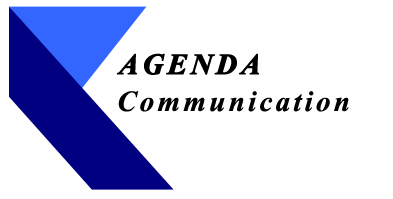
















Geoff Pearson
Director







Registered Training Organisation
NC4780


Communication Systems Services

In a nutshell
A Communication Network Analysis identifies the weaknesses, blockages and flashpoints in a workplace's communication systems and then suggests solutions to these. It is an important preparatory step before running any communication skills training.
For more detailed information, read on...
What is a Communication Network Analysis?
The Communication Network Analysis (CNA) was pioneered in the 1990s by Agenda Communication in response to two factors:
- comments from various employers that communication skills training their employees had attended was too generic and did not address the specific needs of their employees, and
- the realisation that the communication systems in many workplaces actively prevented employees from using their communication skills fully.
Alistair Rylatt, in his book Learning Unlimited, tells a fishing story which clearly illustrates this point. Click on the picture of the fish on the right to hear it, or scroll down to read on.
The CNA addresses both these issues through a process of analysing the communication skills of employees and the current effectiveness of the workplace’s communication systems.
What happens exactly?
In consultation with all the key players in the workplace, the Agenda consultant identifies and examines the effectiveness of all the workplace communication channels (both verbal and written) that are relevant to the workplace’s stated goals for the employees in question. This includes an examination of such things as:
- workplace signage
- notices and noticeboards
- relevant workplace documentation
- meetings involving the employees in question
- the channels by which decisions made elsewhere reach the employees. (This may include: emails, memos, logbooks, toolbox meetings...)
- the channels by which employees may feed their comments, ideas, suggestions etc. to others
- the awareness of all parties of the existence / importance of these communication channels
Many of the most common communication problems in the workplace are caused not by employees' poor communication skills but by inadequate communication systems. Such systems may have been quite efficient when they were set up, but perhaps because of the growth of the workforce, or simply changes in the way individuals prefer to operate, the systems are no longer effective.
Very often, what was once an informal passing-on of information is no longer reliable; often, too, an operational system may change, but related documentation hasn't change with it, so that forms are out of kilter with the information they are supposed to relay.
Whatever the issues, the CNA is designed to examine all the relevant communication channels and to recommend where improvements could be made.
Why carry out a CNA before training?
It is important that changes to communication systems take place before any training programs start, so that the training program can then reflect the new systems and cover the skills required by them.
The CNA also allows the Agenda consultant to ‘get under the skin’ of the culture of the workplace – to learn its terminology; the way it operates; its documentation processes; the hierarchies; the appropriate communication channels etc. The value of this, once training starts, is immeasurable because it allows the trainer to tailor everything he/she does to the needs of the specific group of trainees, and to respond accurately and relevantly to trainees’ questions.
Our experience shows us that, with the CNA, the trainer is also informed about the Big Picture of the workplace – that is, how all of its sections interact and how the workplace’s products are produced and / or services are delivered.
For employees, too, this Big Picture is often missing, commonly leading to employees not understanding why certain communication is crucial at certain points.
The CNA puts the trainer in a position to plug the gaps in that picture, affording allowing employees a better understanding of what communication skills they need for their job role, and why. This is highly motivating for trainees and trainer alike.
What does the CNA Report show?
The CNA Report includes an in-depth description and analysis of the communication channels identified as relevant to the target group of employees. It sets out the findings of this analysis and makes practical recommendations for making any improvements to these.
The principal criterion for suggesting an improvement is that it will improve efficiency, productivity, safety and / or quality.
Typically, recommendations will include such things as:
- adding section headings and sectioning lines to noticeboards and systems for dealing with old notices
- standardising signage messages
- formalising communication channels where informal channels have led to problems
- reformatting documentation to allow for more effective communication of vital information
- standardising forms for similar tasks
- producing templates for standard correspondence
- simplifying the language (i.e. using Plain English) in memos from management to shopfloor operators
Each workplace is unique. Its communication systems will be different from any other workplace. But whatever your workplace's particular communication issues are, the CNA is designed to identify them and help you address them.
Contact us for a free, no-obligation consultation.



Communication Network Analysis
A couple of examples
In one WA workplace, the drawing-up and displaying of a chart of information detailing house styles for various clients sped up productivity overnight because it removed the need for employees to continually stop work to ask supervisors for that information.
This was a particularly interesting case since the management had originally considered the employees had reading problems when it came to interpreting jobsheets.
The CNA identified that the staff actually had no problems reading the jobsheets at all. The problem was with the lack of information on the jobsheets themselves.
As a result, the ensuing training program was much more accurately targeted at the real needs of the employees and the workplace.
In another WA workplace, a simple change to a post-production maintenance report form allowed the machine operators to accurately inform the maintenance crew whether the machine's removable parts needed any attention before the next run.
This simple change led to the end of a debilitating “us and them” situation that had been present for more than a year, as each side blamed the other for production problems linked to the removable parts.
Once the form had been changed, the communication skills training program that followed focussed on ensuring everyone understood how to complete the new form.
It is impossible to say exactly what a CNA will uncover in any particular workplace. It will, however, help to ensure your communication skills training program is not focussing on the wrong target.
For a free consultation to discuss how this might apply in your workplace, please contact us.
A Fishy Tale
Click on the fish.
